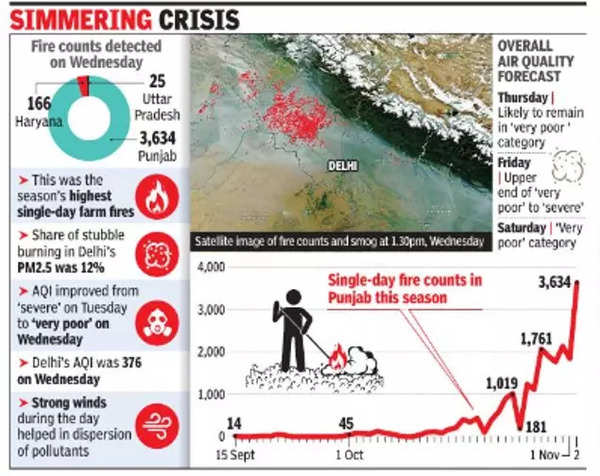Track the pollution level in your city
However, Delhi’s air quality, which had reached the “severe” category on Tuesday, improved slightly and touched “very poor” on Wednesday. As strong winds blew during the day, it helped in dispersion of pollutants.

The city’s air quality index was recorded at 376 on Wednesday against 424 a day earlier. According to Indian Agricultural Research Institute (IARI), which follows the standard protocol 2021 notified by Commission for Air Quality Management in National Capital Region and Adjoining Areas (CAQM), satellites detected 3,634 paddy residue burning events in Punjab, 166 in Haryana and 25 in Uttar Pradesh on Wednesday. This was the first time this season when the single-day count of farm fires crossed 3,600.
As north-west India received rain in the last week of September and another spell from October 7 to 12, paddy harvesting was delayed and picked up in the second half of October. IARI’s data showed that daily fire counts were low till October 20. However, it started picking up in October-end. On October 24, Punjab witnessed 1,019 fire counts and the per day farm fires was 2,067 on October 28.
Between September 15 and November 2, Punjab reported 21,480 stubble burning incidents this year against 18,066 in 2021. However, Punjab recorded higher counts during the same period in 2020 with 41,176 paddy residue burning events.
Haryana recorded 2,249 farm fires between September 15 and November 2 this year. However, they were more during the same period last year (3,241) and 2020 (2,606). Experts said burning of stubble would continue till November 15.
Though stubble burning has hit the season’s peak, its share in Delhi’s PM2.5 was 12% on Wednesday. System of Air Quality and Weather Forecasting And Research (SAFAR), the forecasting body under Union ministry of earth sciences, said contribution was low due to unfavourable transport-level wind flow.
“The air quality improved on Wednesday as wind speed picked up on Tuesday night. Strong winds ranging from 6 to 20 kmph blew on Wednesday and helped in dispersal of pollutants. However, as wind direction is likely to be north-westerly on Thursday, the share of stubble burning is predicted to be around 23%,” said VK Soni, head, environment and research centre, IMD.
RK Jenamani, senior scientist, IMD, said it was after four days when the wind speed had improved. The air quality is likely to remain in the “very poor” category on Thursday, but it may reach the upper-end of “very poor” or “severe” categories on Friday.
Meanwhile, CAQM held a meeting with implementing agencies of the NCR districts of Haryana, Rajasthan and Uttar Pradesh. They were asked to enhance the implementation of Stage I, II and III under GRAP with stringent actions, including heavy penalties against gross defaulters flouting the statutory directions of the commission.






